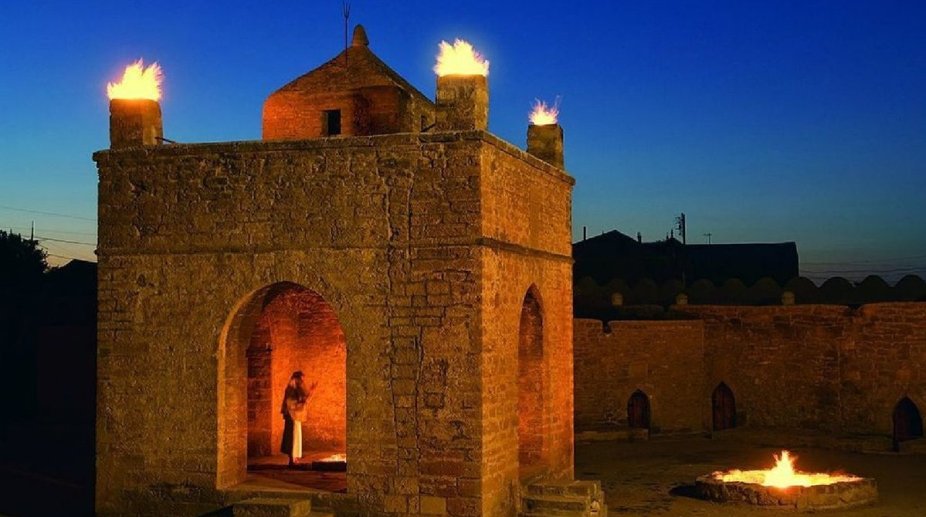Discover the flames that lasted centuries: Atashgah Zoroastrianism Fire Temple (Azerbaijan)

Azerbaijan's Atashgah Zoroastrianism Fire Temple—the Atish Kada— is a strange place that leaves people intrigued enough to keep coming back for more. The unfading flames, Hindu ceremonies, and Zoroastrian people play a mysterious role in keeping people awed by this place.
Azerbaijan is renowned for its sacred flame, which has burned for centuries.
Here, ancient traditions were carried out with the same flames burning brightly today. It reveals how Zoroastrian people lived together and delivers a message on how we should treat fire with the same dignity we give to water, trees, and shelter.
The locals symbolize fire as truth and honesty.
In ancient times, the Silk Road connected Azerbaijan (it was a pathway for not only trade but to exchange ideas and beliefs.)
Hinduism, a prominent religion in India, had traders and nomads who were curious about other lands. And Fire Temple is one such place that intrigued them.
The traders embarked on a journey through mountains, valleys, deserts, and rivers. It takes months to arrive here. The Silk Road brought them to this temple complex, where they were welcomed by the priests and filled with admiration for the Zoroastrian faith.
The place was recognised faster because of the Silk Route, which later spread the message of peace and unity. Eventually, some settled in the land of Azerbaijan, drawn by the eternal flames and the sense of unity they had experienced.
When you enter the temple, you will find prayer rooms influenced by Hinduism. The air is thick with the scent of burning oil, and the sound of crackling flames is present. The temple itself is a marvel of architecture, with intricate designs and unique artwork that cast a warm, welcoming aura around it.
The burning fire is now being put out using artificial kerosene pipes.
Which leads to the question - What happened 54 years ago for the fire to turn down?
In the 18th century, due to the greed for profits and arrogance towards Zoroastrian culture grew - it led to extinguishing the fire. It's when industrialization took over and created new demand for a new way to generate energy in Azerbaijan — crude oil.
The oil companies were eager to extract and profit from this valuable resource. And they knew the temple was a sacred place. At first, they hesitated to drill within its boundaries, but the temptation to increase profits was addicting. Soon, they discovered significant oil reserves within the temple.
But did they care about the spiritual significance of the temple? Not one bit. They were relentless in their pursuit of profit, draining the oil reserves and leaving the flame flickering weakly.
The locals were outraged. They felt betrayed when the oil companies destroyed the very thing they worshiped daily. But these big corporations were too powerful, and the temple's reserves were depleted soon.
What was left was a sad reminder of the power of greed and the disregard for cultural heritage. As a result, in 1969, the flame at the Atashgah Fire Temple was extinguished because of the exploitation of oil.
This place is filled with stories. As Azerbaijan became a part of the Russian Empire in the 19th century, the Atashgah Fire Temple underwent significant changes in the following years …
The museum nearby provides a fascinating insight into the temple. Artifacts dating back centuries are on display. These displays showcase the traditions of the people and are all stored in one place.
At the Atashgah Fire Temple, the exhibition is a journey through time, tracing the history of the temple and the people who have come here over the centuries.
As you walk through the exhibition, you will see objects that were made during the temple's history. These are ancient manuscripts and texts that tell more about the events that happened in Azerbaijan.
You see beautiful carpets, intricate metalwork, and delicate pottery, all done by skilled artisans who passed their craft through generations.
But the exhibition is not about the past. It also looks to the future, with displays of modern art and design that reflect the vibrant creativity of contemporary Azerbaijan.
In conclusion, whether you are a spiritual seeker, relic reveler, or simply come here to worship in the Atashgah Fire Temple, this is definitely a promising spot for you. Come and experience the flames’ warmth and the architecture’s beauty.

